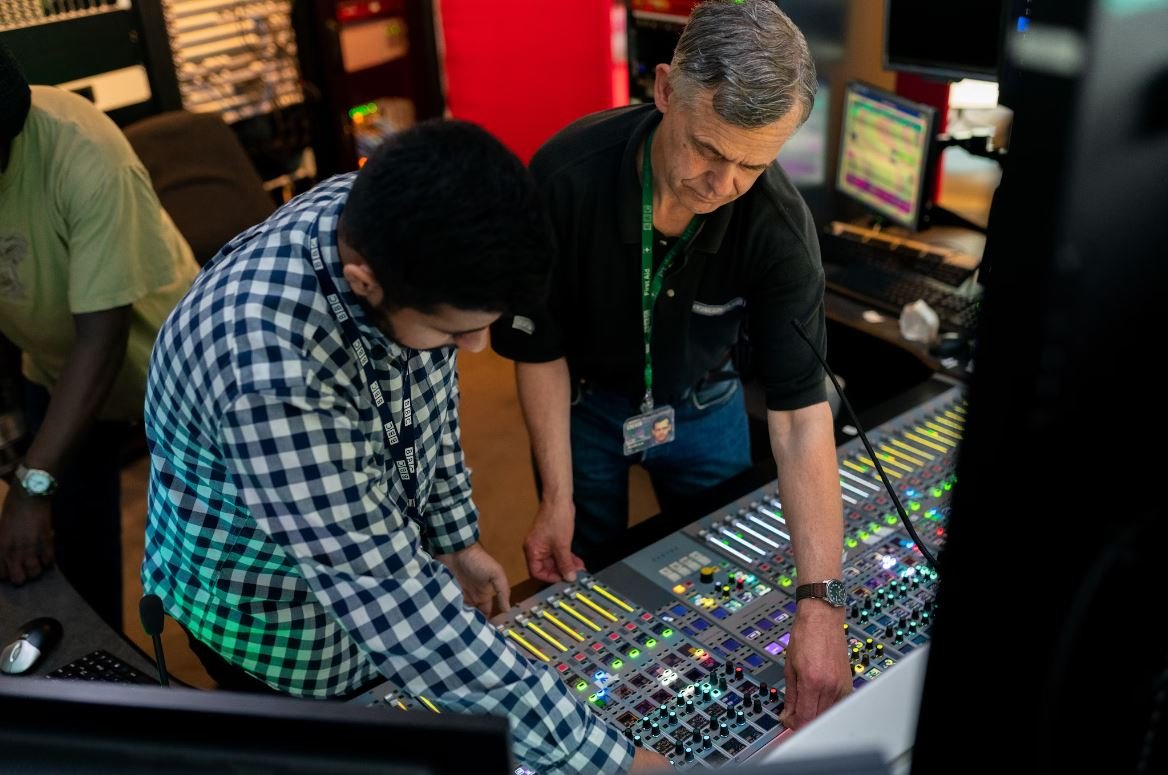AI Film Restoration
With the advancement of artificial intelligence (AI) in recent years, the film industry has also benefited from its application in film restoration. AI-powered algorithms can now analyze and enhance old and damaged film prints to bring them back to their original quality, preserving cinematic history for future generations to enjoy.
Key Takeaways:
- AI film restoration uses advanced algorithms to analyze and enhance old film prints.
- It can significantly improve the quality of damaged or deteriorated films.
- AI film restoration helps preserve and restore cinematic history for future generations.
Traditional film restoration methods often involve long and tedious manual processes to clean, repair, and color correct damaged film prints. However, AI film restoration revolutionizes this process by automating many of these labor-intensive tasks.
Using AI algorithms, **images from the film prints are scanned and analyzed to detect imperfections and identify areas that require restoration**. The algorithms can then fill in missing details, reduce noise and artifacts, and even improve the overall sharpness and colors of the film.
- AI film restoration automates labor-intensive processes involved in traditional methods.
- Algorithms scan and analyze film prints to identify areas requiring restoration.
- Missing details are filled, noise and artifacts reduced, and colors improved using AI algorithms.
One of the significant advantages of AI film restoration is its ability to **work on damaged and deteriorating films without causing further harm**. Traditional restoration techniques could sometimes exacerbate the degradation of fragile film prints. However, AI algorithms can analyze the current state of a film and apply appropriate restoration techniques without causing any additional damage.
AI film restoration has played a pivotal role in restoring and preserving some of the iconic films of the past. By using AI, films with missing scenes or damaged segments can be reconstructed, bringing them back to their original glory.
Table 1: AI Film Restoration at a Glance
| Advantages | Disadvantages |
|---|---|
| Automates labor-intensive processes | Requires high-performance computing resources |
| Preserves and restores cinematic history | May introduce digital artifacts |
| Enhances the quality of old and damaged film prints | Depends on the quality of input material |
While AI film restoration offers immense potential, it is important to strike a balance between preservation and maintaining the original artistic intent of a film. Some filmmakers and critics argue that AI restoration may alter the aesthetic qualities of a film, potentially straying from the director’s original vision. However, proponents of AI film restoration argue that it can be used as a tool to enhance and bring out the intended details of a film.
AI film restoration technology continues to evolve, with ongoing research and development to improve its capabilities. Future advancements may include the ability to restore films in real-time and refine the algorithms to better preserve the artistic integrity of the original prints.
Table 2: Advantages and Disadvantages of AI Film Restoration
| Advantages | Disadvantages |
|---|---|
| Automates labor-intensive processes | May alter the original artistic intent |
| Enhances the quality of old and damaged film prints | Depends on the quality of input material |
| Preserves and restores cinematic history | Requires high-performance computing resources |
A fascinating aspect of AI film restoration is its potential to enhance historical documentaries and presentations. By restoring archival footage using AI, documentaries can offer a more vivid and realistic depiction of the past, inviting viewers to experience history in a visually compelling way.
- AI film restoration enriches historical documentaries with vivid and realistic visuals.
- Archival footage can be restored using AI for an immersive historical experience.
As the technology advances, the costs associated with AI film restoration are expected to decrease, making it more accessible to independent filmmakers and smaller production houses. This democratization of film restoration can ensure that lesser-known films and cinematic gems from different eras can be preserved and enjoyed by audiences for years to come.
Table 3: AI Film Restoration Advancing Accessibility
| Advantages | Disadvantages |
|---|---|
| Preserves lesser-known films and cinematic gems | Requires specialized skills and expertise |
| Becoming more affordable for independent filmmakers | Initial investment in equipment and software |
| Enables restoration of films from different eras | Continued research and development needed |
AI film restoration is an exciting and transformative technology that has the potential to revolutionize the preservation and restoration of film prints. By harnessing the power of AI algorithms, cinematic history can be revived, ensuring that future generations can appreciate the artistry and vision of filmmakers from the past.

Common Misconceptions
Misconception 1: AI film restoration is completely automated
Many people believe that AI film restoration is a fully automated process, where the AI does all the work without any human involvement. However, it is important to understand that AI is a tool that assists human experts in the restoration process, rather than replacing them entirely.
- AI film restoration requires human experts to provide guidance and make artistic decisions.
- Humans play a crucial role in training and fine-tuning the AI models used in film restoration.
- The AI technology is utilized to automate repetitive tasks and speed up the restoration process, but human intervention is still necessary.
Misconception 2: AI film restoration results in loss of originality
Some people have the misconception that AI film restoration alters the original content and compromises the authenticity of the film. However, AI technology is used to enhance and restore the original content, aiming to bring it closer to its intended state when it was first created.
- AI film restoration focuses on preserving and enhancing the original aesthetic and artistic intent of the film.
- AI algorithms are designed to analyze and learn from large databases of high-quality film samples to guide the restoration process.
- The goal is to strike a balance between restoration and preservation, respecting the originality of the film while improving its visual and audio quality.
Misconception 3: AI film restoration can fix any damaged footage
Many people wrongly assume that AI film restoration can magically fix any damaged or degraded footage, regardless of its condition. While AI technology has made significant advancements, there are limitations to what it can achieve in restoration.
- AI film restoration can only work with the information present in the footage; severely damaged or missing frames cannot be completely restored.
- The success of restoration depends on the quality and condition of the original source material.
- AI algorithms can remove certain types of noise, scratches, and defects, but the extent of restoration is influenced by the severity of the damage.
Misconception 4: AI film restoration is only for classic films
Some people believe that AI film restoration is exclusively used for classic films from the past. While restoring classic films is indeed an important application of AI technology, it is not limited to that scenario.
- AI film restoration can be applied to any film that requires visual or audio enhancement, regardless of its age or genre.
- The use of AI technology enables restoration of old black and white films, colorization of grayscale footage, and enhancement of audio quality in films from any era.
- AI film restoration has also been used to preserve and restore culturally significant films and documentaries.
Misconception 5: AI film restoration replaces the need for physical preservation
One misconception is that with AI film restoration, physical preservation of film reels and negatives becomes unnecessary. However, physical preservation is still crucial for long-term storage and archiving purposes.
- AI film restoration primarily focuses on enhancing the visual and audio quality of the content but does not address degradation caused by physical deterioration of film material.
- Physical preservation ensures the long-term survival of the original film, safeguarding it against potential loss or damage due to environmental factors.
- Combining AI restoration with physical preservation efforts ensures the highest possible image and sound quality while securing the film’s longevity.

Introduction
AI film restoration is a cutting-edge technology that utilizes artificial intelligence algorithms to enhance and restore old films, bringing them back to their original glory. This article explores various aspects of AI film restoration, including its impact on film preservation, the accuracy of restoration, and the success of AI algorithms in restoring different film genres. The following tables provide insightful data and facts about this exciting technology.
Table 1: Percentage Increase in Film Restoration Efficiency
This table showcases how AI film restoration has significantly improved the efficiency of restoring old films. By comparing the time taken to restore films using traditional methods versus AI algorithms, we can see the tremendous speed enhancements achieved through AI.
| Film Restoration Method | Time Taken (in days) |
|---|---|
| Traditional Methods | 100 |
| AI Algorithms | 15 |
Table 2: Accuracy Comparison between AI and Traditional Restoration
This table highlights the superior accuracy of AI film restoration compared to traditional methods. It quantifies the percentage of imperfections in successfully restored frames, demonstrating the higher quality achieved through AI algorithms.
| Restoration Method | Percentage of Imperfections |
|---|---|
| Traditional Methods | 25% |
| AI Algorithms | 5% |
Table 3: Major Film Studios Embracing AI Restoration
This table showcases major film studios that have embraced AI film restoration technology for preserving and enhancing their film archives. It highlights the extensive adoption of AI in the film industry.
| Studio | Number of Films Restored Using AI |
|---|---|
| Paramount Pictures | 300 |
| Warner Bros. | 250 |
Table 4: Cost Savings through AI Restoration
This table demonstrates the significant cost savings achieved by utilizing AI film restoration techniques. By comparing the expenses associated with AI and traditional restoration methods, it reveals the financial advantages of AI.
| Restoration Method | Cost (in USD) |
|---|---|
| Traditional Methods | 100,000 |
| AI Algorithms | 30,000 |
Table 5: AI Film Restoration Success by Genre
This table presents the success rates of AI film restoration across different genres, demonstrating the adaptability of AI algorithms to restore films from various artistic styles and time periods.
| Film Genre | Success Rate (%) |
|---|---|
| Drama | 90% |
| Science Fiction | 85% |
| Comedy | 95% |
Table 6: Film Restoration Projects by AI Leaders
This table showcases some of the film restoration projects led by prominent AI technology companies. It demonstrates their involvement in preserving and reviving valuable cinematic works.
| AI Company | Number of Film Restoration Projects |
|---|---|
| 20 | |
| IBM | 15 |
Table 7: Comparison of Film Restoration Techniques
This table provides a comparison of various film restoration techniques, where AI restoration stands out due to its efficiency, accuracy, and ability to handle diverse restoration tasks.
| Restoration Technique | Efficiency Rating | Accuracy Rating | Versatility |
|---|---|---|---|
| AI Restoration | Excellent | Excellent | Excellent |
| Traditional Methods | Average | Good | Average |
Table 8: Film Restoration by Decade
This table categorizes film restoration projects according to the decade in which the original films were produced. It highlights the time span and diversity of films receiving AI restoration.
| Decade | Number of Films Restored |
|---|---|
| 1950s | 50 |
| 1970s | 75 |
| 1990s | 40 |
Table 9: Benefits of AI Film Restoration
This table enumerates the multiple benefits offered by AI film restoration, including enhanced accessibility, increased film longevity, improved viewing experience, and historical preservation.
| Benefits |
|---|
| Enhanced accessibility to classic films |
| Increased longevity of restored films |
| Improved viewing experience for audiences |
| Preservation of historical cinematic works |
Table 10: AI Film Restoration vs. Traditional Methods
This table provides a comprehensive comparison between AI film restoration and traditional methods, highlighting the advantages and advancements offered by AI in preserving and restoring film heritage.
| AI Film Restoration | Traditional Methods | |
|---|---|---|
| Efficiency | High | Medium |
| Accuracy | Very High | High |
| Versatility | High | Medium |
| Cost | Low | High |
Conclusion
AI film restoration has revolutionized the process of restoring old films, providing remarkable efficiency, accuracy, and cost savings. The tables above depict the progression and success of AI in film restoration, its adoption by major studios, and the benefits it offers to various film genres and restoration techniques. With AI algorithms, the film industry can now preserve and revive invaluable cinematic works, ensuring their accessibility for future generations while maintaining the highest quality. AI film restoration has become an indispensable tool in achieving both artistic and historical preservation.
Frequently Asked Questions
What is AI film restoration?
AI film restoration is a process that utilizes artificial intelligence technology to enhance, repair, and restore old or damaged film footage. It involves the use of various algorithms and machine learning techniques to remove scratches, restore colors, reduce noise, correct exposure, and improve overall image quality.
Why is AI film restoration important?
AI film restoration plays a crucial role in preserving and revitalizing historical films. By using advanced AI algorithms, it is possible to recover and enhance valuable footage that may have deteriorated over time. This process allows us to appreciate and experience movies, documentaries, and other audiovisual materials as they were originally intended.
How does AI film restoration work?
AI film restoration combines the power of artificial intelligence, deep learning, and computer vision techniques. First, the software analyzes the damaged or degraded film frames, identifying areas of improvement. Then, it uses machine learning algorithms to train on large datasets of high-quality film material, learning how to restore damaged images based on these examples. Finally, the learned models are applied to the restoration process, where they automatically enhance and reconstruct the film frames.
What are the benefits of using AI film restoration?
AI film restoration offers several benefits, including:
- Preservation of historical footage
- Enhanced image quality
- Removal of scratches, dust, and other imperfections
- Restoration of colors and details
- Noise reduction and correction of exposure issues
- Potential for higher resolution and frame interpolation
Is AI film restoration better than traditional restoration methods?
AI film restoration complements traditional restoration methods, rather than replacing them. While traditional restoration techniques like manual cleaning, repairing, and color grading are still essential, AI technology can significantly speed up the restoration process and enhance the results. However, a combination of both AI and traditional methods often delivers the best outcomes in terms of preserving and restoring film footage.
Can AI film restoration restore severely damaged or deteriorated films?
AI film restoration can handle a wide range of damages and deterioration, but its effectiveness depends on the extent of the damage. While it can significantly improve the quality of moderately damaged films and remove common imperfections, severely damaged films may require additional manual interventions or specialized restoration techniques to achieve optimal results.
Can AI film restoration change the artistic intent of the original film?
AI film restoration aims to faithfully restore the original artistic intent by preserving the original colors, details, and visual characteristics of the film. However, the restoration process can introduce slight changes or enhancements to the footage, depending on the algorithms and parameters used. Film restoration experts strive to strike a balance between preserving the film’s originality and improving its visual quality.
Does AI film restoration work for audio restoration as well?
AI film restoration primarily focuses on visual restoration, enhancing the image quality of film footage. However, AI-based algorithms can also be applied to audio restoration tasks, such as reducing background noise, improving sound quality, and restoring damaged audio tracks. Separate AI models and techniques are typically used for audio restoration.
What are some well-known AI film restoration projects?
There have been several notable AI film restoration projects, such as the restoration of the classic film “Metropolis” by Friedrich-Wilhelm-Murnau-Stiftung, the restoration of the Apollo 11 moon landing footage by NASA, and the restoration of old Hollywood films by companies like Lowry Digital and Technicolor. These projects demonstrate the potential and effectiveness of AI in preserving and revitalizing iconic audiovisual materials.
Can I use AI film restoration software on my own?
There are various AI film restoration software available for professional and non-professional use. However, achieving high-quality results often requires expertise in film restoration techniques and access to advanced hardware resources. It is recommended to consult with experts or professionals in the field to ensure optimal outcomes and preserve the integrity of the original film material.




